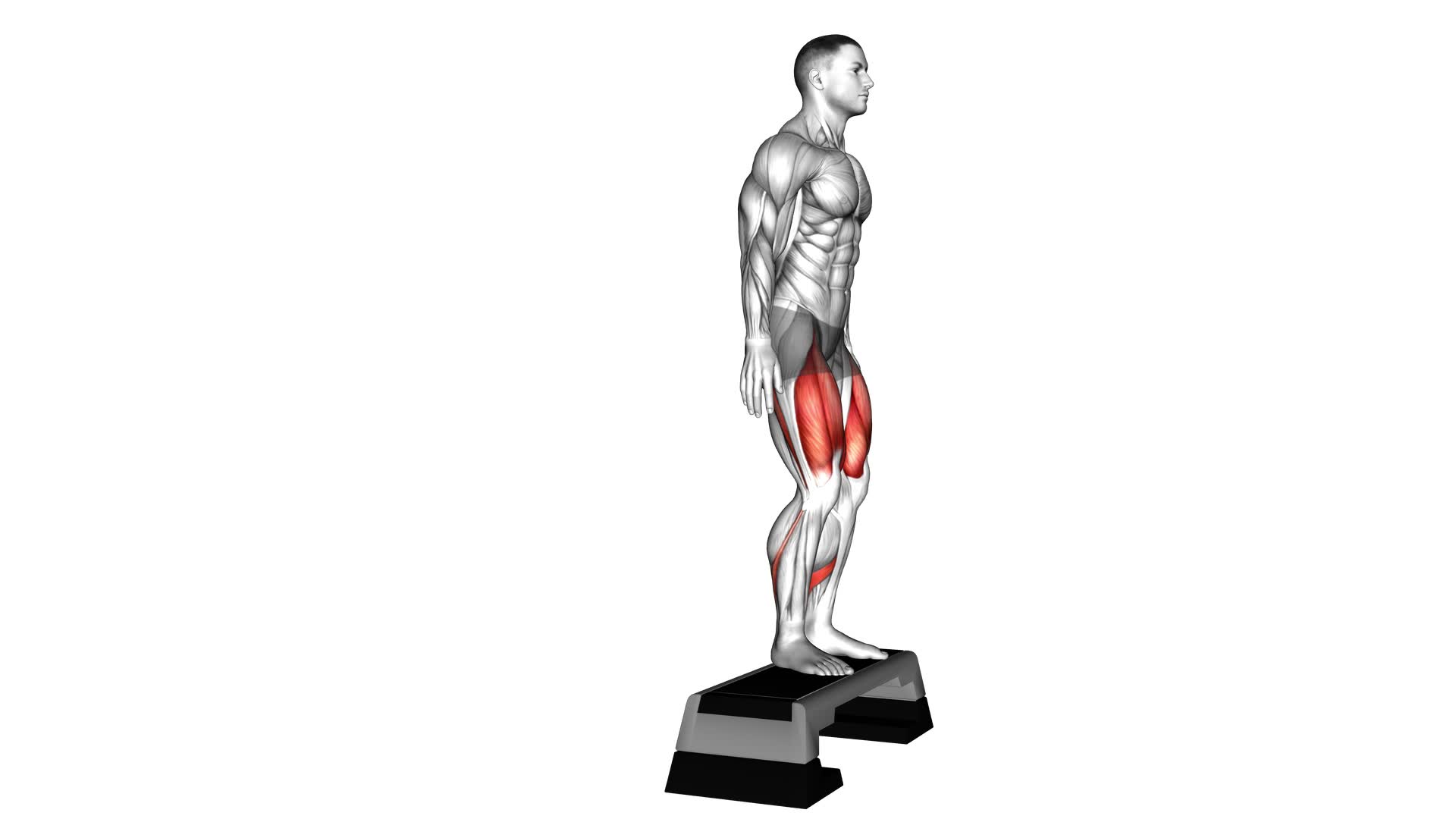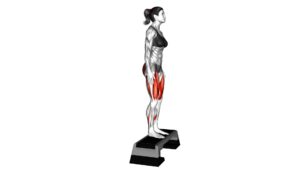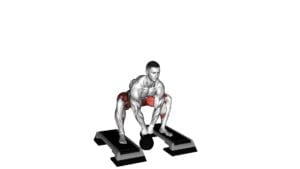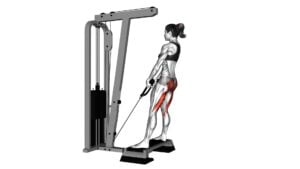Bodyweight Step-up on Stepbox – Video Exercise Guide & Tips

Are you looking for an effective lower body exercise that you can do at home? Look no further than the bodyweight step-up on a stepbox.
Watch This Exercise Video
In this video exercise guide, we'll show you the proper form and technique, along with variations and progressions to keep challenging yourself.
Avoid common mistakes and maximize your results with our helpful tips.
Get ready to step up your workout game and achieve stronger, toned legs.
Let's get started!
Key Takeaways
- Bodyweight step-up on a stepbox enhances cardiovascular fitness.
- Incorporating weights, such as dumbbells or kettlebells, maximizes results.
- The exercise can be modified to suit different fitness levels.
- Maintaining proper technique and form is important for safety and effectiveness.
Benefits of Bodyweight Step-up on Stepbox
You can maximize your workout by incorporating the bodyweight step-up on a stepbox, reaping numerous benefits such as increased lower body strength and improved balance. The bodyweight step-up primarily targets the quadriceps, hamstrings, and glutes, making it an effective exercise for developing strong and toned lower body muscles. As you step up onto the box, your quadriceps work to extend your knee, while your hamstrings and glutes help to stabilize and support your body. This not only strengthens these muscles but also improves their endurance and overall function.
Additionally, the bodyweight step-up on a stepbox provides cardiovascular benefits. This exercise elevates your heart rate, increasing blood flow and oxygen delivery to your muscles. As a result, your cardiovascular system becomes more efficient at pumping blood and delivering oxygen throughout your body. This can lead to improved endurance and stamina, allowing you to engage in other physical activities for longer periods without feeling fatigued.
Incorporating the bodyweight step-up on a stepbox into your workout routine is a practical and effective way to target multiple lower body muscles while also improving your cardiovascular fitness. By adding this exercise to your routine, you can enhance your overall strength, balance, and endurance.
Proper Form and Technique
To perform the bodyweight step-up on a stepbox with proper form and technique, focus on maintaining a stable and controlled movement throughout the exercise. This will help you maximize the benefits and minimize the risk of injury. Here are some key points to keep in mind:
- Common injuries and how to prevent them:
- Sprained ankles: Ensure that your foot is securely placed on the stepbox before stepping up. Avoid rushing or using excessive force.
- Knee pain: Make sure to align your knee with your foot as you step up and down. Avoid letting your knee cave inwards or move too far forward.
- Lower back strain: Engage your core muscles and maintain good posture throughout the exercise. Avoid leaning too far forward or backward.
- Importance of proper footwear for bodyweight step ups:
- Wear shoes with good arch support and cushioning to protect your feet and ankles.
- Opt for shoes with a non-slip sole to maintain stability on the stepbox.
- Avoid wearing shoes with a high heel or unstable platform, as they can increase the risk of injury.
Variations and Progressions
As you progress in your bodyweight step-up on a stepbox routine, you can explore different variations and progressions to further challenge your muscles and enhance your overall fitness. There are several advanced techniques you can incorporate into your workouts to make them more challenging and effective.
One option is to add weight to your step-ups. You can hold dumbbells or kettlebells in your hands as you perform the exercise. This will increase the resistance and make your muscles work harder.
Another variation is the explosive step-up. Instead of stepping up slowly, you can explode upwards, pushing off with your leading leg and driving your knee up towards your chest. This will engage your fast-twitch muscle fibers and improve your power and explosiveness.
You can also try performing step-ups on an unstable surface, such as a Bosu ball or a balance board. This will challenge your balance and stability, forcing your muscles to work harder to maintain control.
In terms of equipment options, you can use different heights of stepboxes to vary the difficulty of the exercise. Starting with a lower box and gradually progressing to a higher one will continuously challenge your muscles and keep your workouts interesting.
Common Mistakes to Avoid
When progressing in your bodyweight step-up routine, it's important to be aware of common mistakes that can hinder your progress and potentially lead to injury. To ensure you're performing the exercise correctly and maximizing its benefits, here are some common mistakes to avoid:
- Using improper form: One of the most common mistakes isn't maintaining proper form throughout the movement. This includes keeping your back straight, engaging your core, and stepping up with control. Avoid hunching over, arching your back, or using excessive momentum.
- Neglecting proper foot placement: Another mistake is placing your foot too close or too far from the stepbox. To avoid straining your knee or ankle, make sure your entire foot is on the stepbox and your knee is aligned with your toes.
- Rushing through the exercise: It's important to perform the bodyweight step-up with control and stability. Avoid rushing through the movement or bouncing off the stepbox. Instead, focus on a slow and controlled pace, emphasizing the contraction of your leg muscles.
By avoiding these common mistakes and practicing the correct form, you can ensure a safe and effective bodyweight step-up routine. Remember to start with a suitable stepbox height and gradually increase the intensity as you progress.
Happy stepping!
Tips for Maximizing Results
Maximize your results by incorporating these tips into your bodyweight step-up routine.
One way to increase the effectiveness of this exercise is by incorporating weights. By holding dumbbells or using a weighted vest, you can add resistance and challenge your muscles even more. This will help to build strength and increase muscle tone. Additionally, by adding weights, you'll also increase the calorie burn, making the exercise more efficient for weight loss.
Another tip for maximizing your results is to modify the exercise for different fitness levels. If you're a beginner or have limited mobility, you can start by using a lower stepbox or even just a sturdy platform. As you become more comfortable and stronger, gradually increase the height of the stepbox. This will further engage your muscles and make the exercise more challenging.
On the other hand, if you're advanced and looking for an extra challenge, you can incorporate jumps into the exercise. Instead of simply stepping up and down, explode off the ground as you step up, switching legs in mid-air. This will elevate your heart rate and add a plyometric element to the exercise, further enhancing the benefits.
Incorporating weights and modifying the exercise for different fitness levels are two key tips for maximizing your results with the bodyweight step-up on a stepbox. By following these tips, you can make the exercise more challenging, increase muscle strength and tone, and burn more calories.
Frequently Asked Questions
How Many Calories Can I Burn by Doing Bodyweight Step-Ups on a Stepbox?
You can burn a significant amount of calories by doing bodyweight step-ups on a stepbox. This exercise targets your leg muscles and gets your heart rate up, leading to calorie burn.
The number of calories burned will depend on various factors such as your body weight, intensity, and duration of the workout.
Additionally, bodyweight step-ups can help build muscle in your lower body, including your quadriceps, hamstrings, and glutes.
Can Bodyweight Step-Ups Help Me Build Muscle in My Lower Body?
Bodyweight step-ups can definitely help you build muscle in your lower body. By incorporating different variations of the exercise, such as using a stepbox or adding weights, you can target different muscle groups like your glutes, hamstrings, and quads.
The benefits of bodyweight step-ups include increasing strength, improving balance, and enhancing overall lower body stability. Consistency and proper form are key to maximizing the muscle-building potential of this exercise.
Is It Safe for Beginners to Start With Bodyweight Step-Ups on a Stepbox?
Yes, it's safe for beginners to start with bodyweight step-ups on a stepbox. This exercise can help you burn calories and build muscle in your lower body.
If you have any injuries or limitations, there are modifications you can make to ensure safety. Always listen to your body and start with a height that feels comfortable.
As you gain strength and confidence, you can gradually increase the height of the stepbox.
Can Bodyweight Step-Ups on a Stepbox Help Improve My Balance and Coordination?
Bodyweight step-ups on a stepbox can definitely improve your balance and coordination. By performing this exercise, you're challenging your body to stabilize and maintain control while stepping up and down. This helps to strengthen the muscles in your legs and core, which in turn improves stability.
Additionally, the movement involved in step-ups can increase agility as it requires you to coordinate both your upper and lower body.
Can Bodyweight Step-Ups on a Stepbox Be Modified for Individuals With Knee or Hip Pain?
Modified exercises for knee/hip pain can be beneficial for overall fitness. By making adjustments to the bodyweight step-ups on a stepbox, you can still reap the benefits without causing further discomfort.
Consider reducing the height of the stepbox or performing the exercise with a lower intensity. This will alleviate stress on the knees and hips while still allowing you to improve your balance and coordination.
Always listen to your body and consult a professional if needed.
Conclusion
In conclusion, the bodyweight step-up on a stepbox is a highly effective exercise that targets the lower body muscles while also improving balance and stability.
By maintaining proper form and technique, varying the height of the stepbox, and avoiding common mistakes, you can maximize the benefits of this exercise.
Remember to start at a comfortable level and gradually progress to more challenging variations.
With consistency and dedication, you can achieve great results from incorporating this exercise into your fitness routine.

Author
Years ago, the spark of my life’s passion ignited in my mind the moment I stepped into the local gym for the first time. The inaugural bead of perspiration, the initial endeavor, the very first surge of endorphins, and a sense of pride that washed over me post-workout marked the beginning of my deep-seated interest in strength sports, fitness, and sports nutrition. This very curiosity blossomed rapidly into a profound fascination, propelling me to earn a Master’s degree in Physical Education from the Academy of Physical Education in Krakow, followed by a Sports Manager diploma from the Jagiellonian University. My journey of growth led me to gain more specialized qualifications, such as being a certified personal trainer with a focus on sports dietetics, a lifeguard, and an instructor for wellness and corrective gymnastics. Theoretical knowledge paired seamlessly with practical experience, reinforcing my belief that the transformation of individuals under my guidance was also a reflection of my personal growth. This belief holds true even today. Each day, I strive to push the boundaries and explore new realms. These realms gently elevate me to greater heights. The unique combination of passion for my field and the continuous quest for growth fuels my drive to break new ground.







